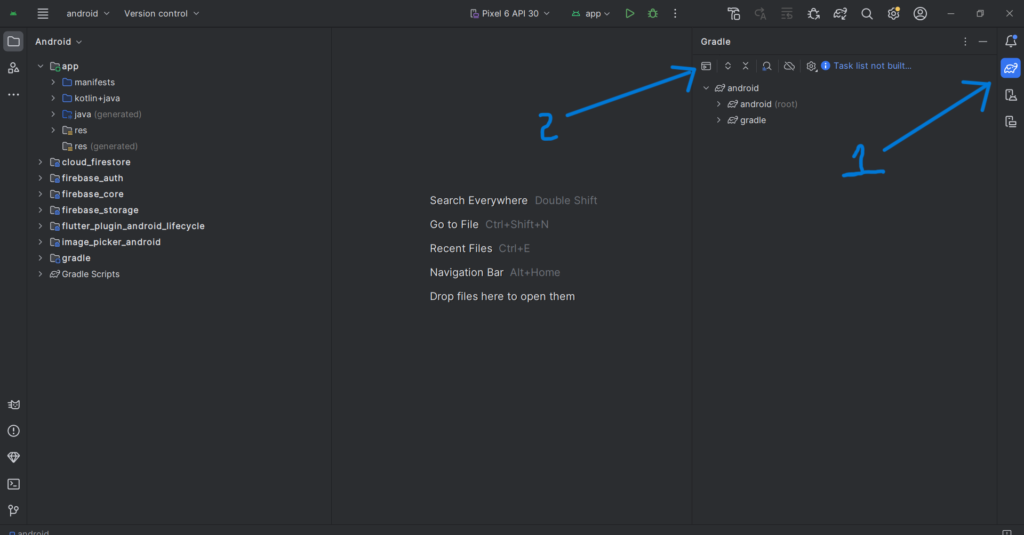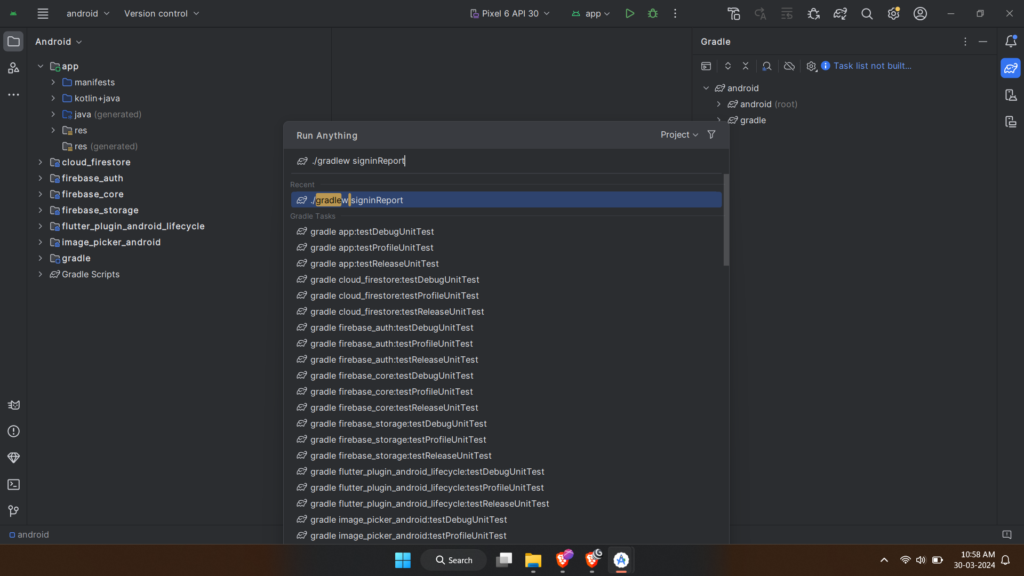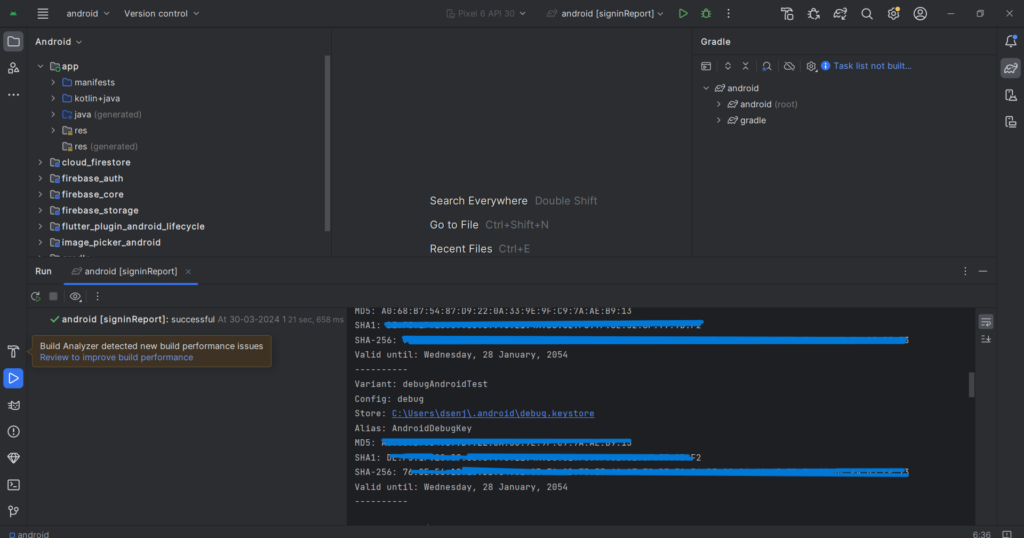Do you also face problems regarding the SHA1 and SHA256 keys while connecting your Android and Flutter projects with Firebase? Do you also want to find SHA1 and SHA256 for your project? how to find SHA1 and SHA256? So today I will tell you the easiest way to generate SHA1 and SHA256 keys in the minimum time.
How to Find SHA1 and SHA256 Fingerprint?
Find SHA1 and SHA256 keys for Flutter or Android Project in Android Studio
Step 1: Open Your Project in Android Studio.
Simply Open Your Project Like this. Ex. Menu -> File -> Open…

Step 2: After Open Your Project, you can see Android folder in your project. So Again Open this ‘Android’ folder in New Windows.
If you don’t understand, then keep following the clip below.

Step 3: After step 2, click on ‘Gradle‘ button, then click on ‘Execute Gradle Task‘ button.

Step 4: Run “./gradlew signinReport” Command in Run Anything.
./gradlew signinReport
Step 5: Wait until run totally. after you will get SHA1, SHA-256, MD5.

Thank You So much for visit our blog. if you like this trick for Unlock the secrets of SHA1 & SHA256 for your project with our easy guide then please share and comment and save in your bookmarks.
Hash capabilities play a vital position in securing statistics and verifying the integrity of virtual information. Among the diverse hash capabilities available, SHA-1 and SHA-256 are two broadly used algorithms that generate unique hash values for input information. In this comprehensive guide, we can delve into the intricacies of SHA-1 and SHA-256, discover their differences, and understand their significance in present day cybersecurity practices. Let’s resolve the arena of hash functions and find out the particular characteristics of SHA-1 and SHA-256.
What is a Hash Function?
Before diving into the specifics of SHA-1 and SHA-256, allow’s first apprehend the concept of a hash function. A hash characteristic is a mathematical set of rules that takes an enter (or message) and produces a hard and fast-size string of bytes, called a hash value or hash digest. The primary motive of a hash feature is to generate a unique representation of the input records, such that even a mild alternate inside the input results in a substantially specific output.
Hash features are typically utilized in numerous cryptographic programs, which include records integrity verification, password garage, digital signatures, and message authentication. By generating a unique hash price for each input, hash features permit records validation and ensure that statistics has now not been tampered with or altered.
SHA-1 (Secure Hash Algorithm 1)
SHA-1 is a cryptographic hash function that produces a a hundred and sixty-bit (20-byte) hash value, normally represented as a 40-individual hexadecimal wide variety. Developed via the National Security Agency (NSA) inside the United States, SHA-1 turned into extensively used for digital signatures, certificates authorities, and facts integrity verification.
However, due to vulnerabilities observed in the algorithm over time, SHA-1 is now taken into consideration insecure for lots cryptographic programs. In 2005, researchers demonstrated collision attacks on SHA-1, wherein special inputs produce the identical hash cost, compromising the security of the algorithm.
As a result of these vulnerabilities, SHA-1 has been deprecated in desire of stronger hash features including SHA-256. While SHA-1 might also still be used in legacy structures, it’s far encouraged to transition to more stable algorithms to ensure strong facts protection and cryptographic safety.
SHA-256 (Secure Hash Algorithm 256)
SHA-256 is a member of the SHA-2 own family of cryptographic hash capabilities, which incorporates SHA-224, SHA-256, SHA-384, and SHA-512. As the name indicates, SHA-256 produces a 256-bit (32-byte) hash fee, offering a better stage of protection and collision resistance in comparison to SHA-1.
SHA-256 is widely utilized in modern-day cryptographic packages, inclusive of virtual signatures, certificates government, blockchain era, and password hashing. The set of rules’s accelerated bit period and complexity make it greater resistant to collision attacks and brute-force attacks, improving information protection and cryptographic strength.
In the context of blockchain technology, SHA-256 performs a vital role in mining and validating blocks in a decentralized community. By producing specific hash values for block headers, miners compete to find a legitimate hash that meets the community’s difficulty target, thereby including a new block to the blockchain.
Differences Between SHA-1 and SHA-256
Hash Length: SHA-1 produces a a hundred and sixty-bit hash fee, whilst SHA-256 generates a 256-bit hash cost. The longer hash period of SHA-256 provides elevated safety and collision resistance.
Security: SHA-256 is taken into consideration more secure than SHA-1 because of its large bit length and resistance to cryptographic assaults. SHA-1 has regarded vulnerabilities that make it susceptible to collision assaults.
Usage: While SHA-1 was extensively used inside the beyond for various cryptographic programs, it’s miles now deprecated in favor of more potent algorithms like SHA-256. SHA-256 is the favored choice for present day safety protocols and cryptographic practices.
Performance: SHA-256 might also require greater computational resources and processing electricity as compared to SHA-1 due to its larger hash period and complexity. However, the alternate-off for improved security is often deemed profitable in cryptographic applications.
FAQS
What is SHA1?
SHA-1 is a cryptographic hash function that processes input data to produce a 160-bit hash value, typically expressed as a 40-digit hexadecimal number. Designed by the NSA, it’s used for data integrity but is vulnerable to collision attacks, leading to its deprecation in favor of more secure algorithms.
What is SHA256?
SHA-256 is a cryptographic hash function that converts any input into a fixed-size, 256-bit output. It’s a key part of blockchain technology, ensuring data integrity and security by producing a unique hash value for each set of data, which is virtually impossible to reverse-engineer.
















